
Полная версия
The most detailed guide around Circum-Baikal Railroad: Irkutsk, Listvyanka, Slyudyanka, Shelekhov
Marshal A.E. Golovanov (1904—1975)
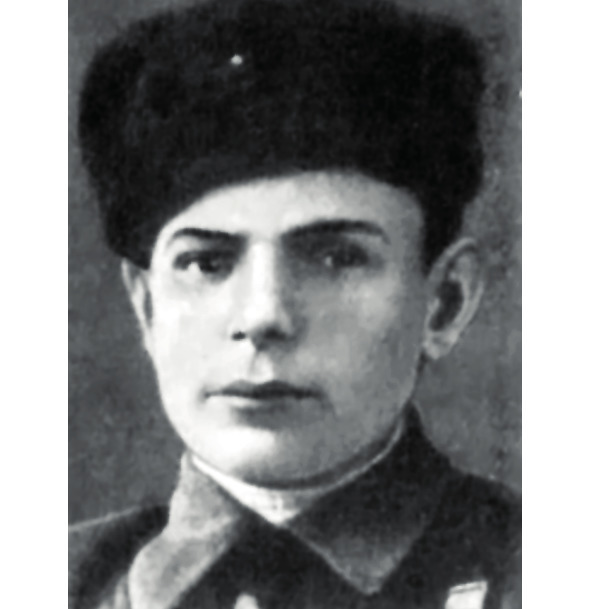


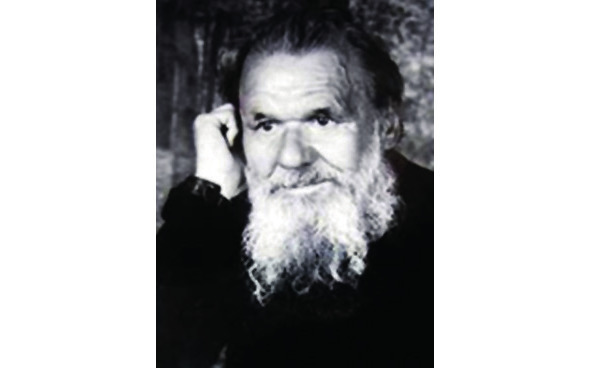
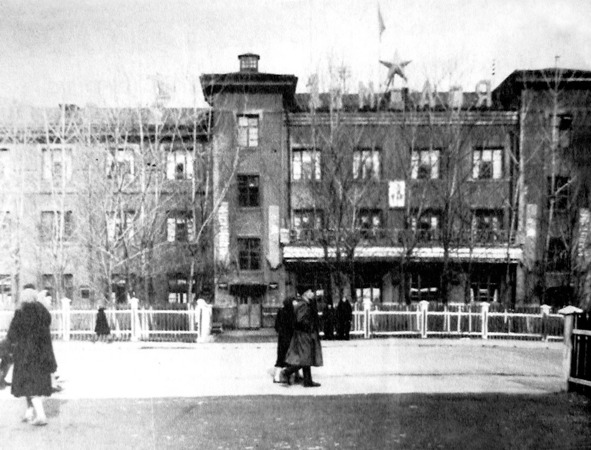

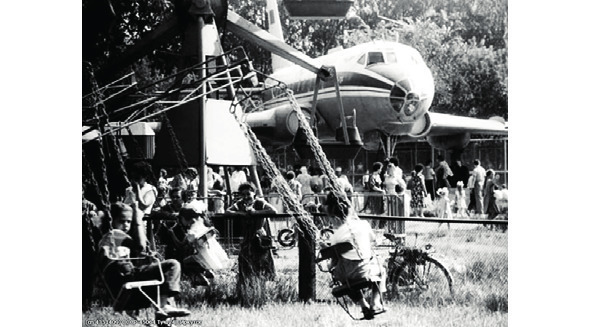
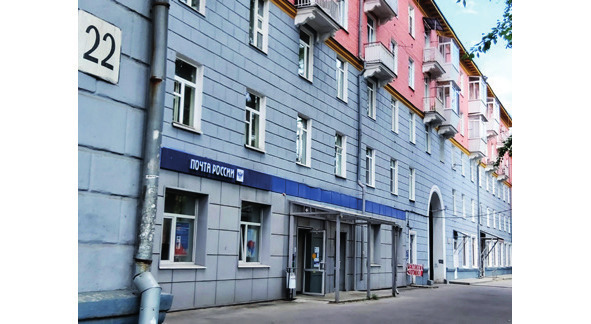
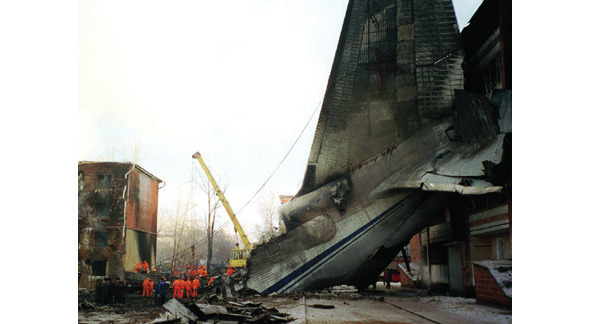
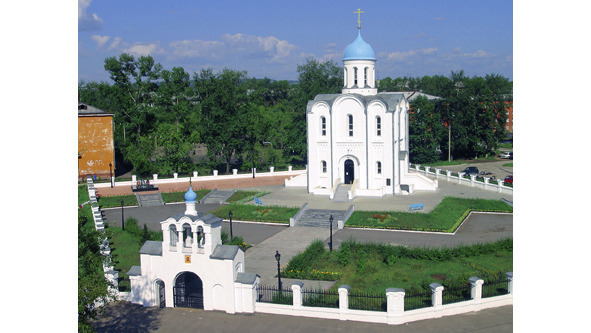

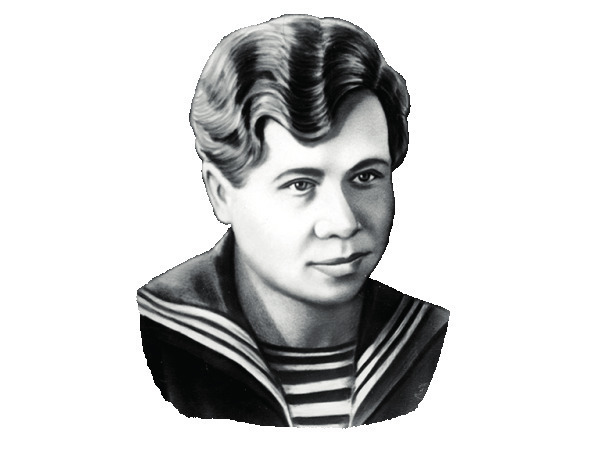
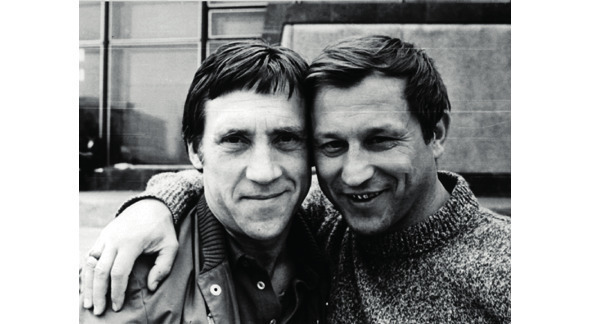
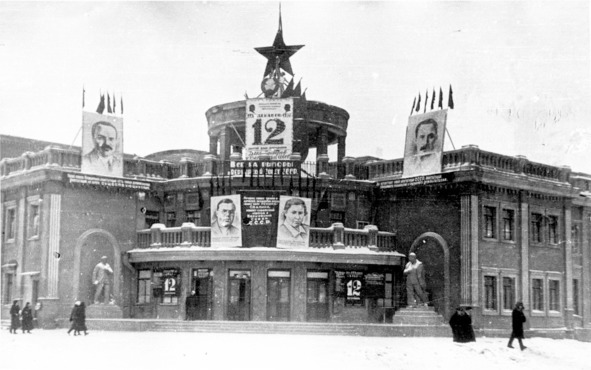
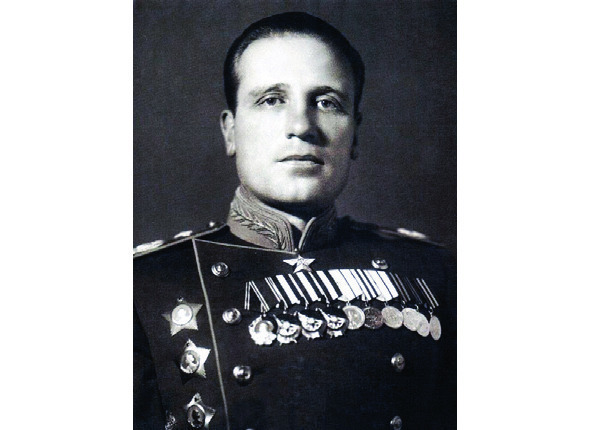
Zhilkino Microdistrict
This concludes our acquaintance with the Irkutsk II area and turn right onto Novatorov Street towards the village of Bokovo. This passage appeared in 1896, when a water pipe was laid here from the Angara river to the Innokentievskaya station. Here, near the border of the aircraft factory, at the Bokovsky cemetery, according to legend, in the spring of 1920, was buried admiral A.V. Kolchak. The graveyard was finally destroyed in 1937 during the construction of the aviation service of the enterprise.
The village itself appeared in 1710, when Savva Bokov, a contributor to the Ascension Monastery, built his house here. On June 13, 1925, the first airport in the history of Irkutsk appeared adjacently to the village, that was just a flat area 600 m long. Already on June 24 of the same year, six aircraft landed here, performing the first great flight of Soviet aviation on the route Moscow—Ulaanbaatar—Beijing —Tokyo. Among the pilots was the future aviation general and Hero of the Soviet Union M.M. Gromov. However, in July 1933, the take-off site was moved to another part of the city, and the village did not receive further development.
The first airplanes in Irkutsk, 1925
Getting to the end of Novatorov Street, we turn right onto Polyarnaya Street, which is the remains of the old Moscow tract. Despite the fact that the decree on the construction of this longest land road in the world in 17th century (5672 km) was issued back in 1689, it reached Irkutsk only in 1749. Before that, as noted by the first historiographer of Eastern Siberia A.I. Losev: «…the usual way was by water along the Angara on ships in the summer time, and in the winter they traveled along the Angara in a sleigh.» By the way, in Bokovo, starting from the end of the 19th century, a ferry operated to the other side of the river. Its remnants can still be seen near the modern autocross track, as well as the old balsam poplar alley along the Moscow Tract.
Road map in Russia at the beginning of the 20th century
The first people settled in this part of the Angara since the founding of Irkutsk, and in 1669, after the creation of a small church hermitage on the lands of the peasant Zhilkin, its modern name Zhilkino was assigned to the area. Having passed the oil depot, we are moving along Polyarnaya Street to the Irkutsk Meat Processing Plant, opened in 1937 (Polyarnaya Str., 97). A little further, behind the automobile ring, there is a mill-elevator of the Irkutsk bakery (Polyarnaya Str., 77). Since 2018, both of these enterprises no longer operate. Once they caused the disappearance of the oldest monastery in Irkutsk in the name of the Ascension of the Lord, founded by the Righteous Elder Gerasim back in 1672. The oldest school in Eastern Siberia has not survived either, founded in 1725 by Archimandrite Anthony (Platkovsky). It burned down in 1876, and in its place in 1936 an ordinary wooden house appeared (nowdays Polyarnaya Str., 74).
View of the Ascension Monastery from the Moscow tract, 1906
Unfortunately, there is also almost nothing left of the largest monastery in Irkutsk. Of the actual church buildings, only the Assumption Church (Polyarnaya Str., 98) has survived, consecrated in 1783 personally by the Venerable Sinesius of Irkutsk. Once upon a time it was a rare example of a temple built into the monastery inclosure not above the gates, but as a continuation of the walls. In addition, with a two-altar composition, which is unique for the stone architecture of Eastern Siberia. It is also interesting that in 1863—1872, during the construction of the new Ascension Cathedral, the relics of the first Irkutsk bishop rested in the Assumption Church. Moreover, in 1836, on the north side of the entrance, a chapel with a holy spring was added, which, according to legend, was extracted by Saint Innocent himself. Unfortunately, in Soviet times, a toilet was placed on its place, and there was no chance of recreating it.
Assumption Church with the Holy Spring, 1914
Let’s try to recreate mentally the image of the monastery, moving clockwise and taking the only preserved temple as a reference point. In the direction of Polyarnaya Street (the former Moscow Trakt), exactly opposite the Assumption Church, once rose the walls of the oldest wooden church in Irkutsk. It was consecrated back in 1692 in the name of the Tikhvin Icon of the Mother of God. In 1731 Innocent Kulchitsky was buried in its underground. It became the only surviving building after the devastating fire of 1783. Unfortunately, it could not survive the fire of the Soviet era, and in March 1932 it was destroyed to clear the territory for the future Irkutsk meat processing plant, as well as most of the monastery buildings. Today, in its place have been created a cruciform square with holy gates, a memorial sign and a belfry have been installed.
Tikhvin Church, 1910
Further to Polyarnaya Street there are two fraternal buildings (Polyarnaya Str., 78 and 80), built in 1898 and 1836, respectively. Both of them were located within the monastery walls, and between them since 1881 there was a bell tower built according to the project of the best Irkutsk architect Baron G.V. Rosen and at the expense of the famous merchant-philanthropist I.I. Bazanov, who was later buried on the territory of the monastery. On the side of the Moscow tract, a hotel for pilgrims has been preserved (Polyarnaya Str., 83), above the entrance of which you can still see the date of construction – 1903. By the way, the first hostelry appeared here back in 1866 thanks to the merchant P.O. Katyshevtsev, a distant descendant of whom is the author of this book. It became the third such place in Irkutsk.
Monastery bell tower with hotel for wanderers, 1899
But the main temple of the monastery – the Ascension Cathedral, to which the central alley led from the bell tower, has not survived to this day. Not without reason the place for its construction back in 1738, the second bishop of Irkutsk – Innocent (Nerunovich) – considered unlucky. Initially, the cathedral was projected in the Siberian baroque style in 1767, but a century later, due to dilapidation, it was dismantled, and in its place in 1872 a majestic temple was made in the Russian-Byzantine style by the architect V.A. Kudelsky. In memory of the church, in 2009, a chapel in the name of the Ascension of the Lord was installed at the location of the main aisle (Polyarnaya Str., 98A).
Ascension Cathedral, 1914
Next to the modern chapel, the building of the kitchen and sacristy built in 1907 (Polyarnaya St., 94) has been preserved, but the church in the name of the Smolensk Icon of the Mother of God, which stood right next to the cathedral, did not survive. It was consecrated back in 1795 and significantly rebuilt in 1841. In 1975 on the site of the temple a typical five-story residential building was built (Polyarnaya St., 80A), which put an end to the restoration of the entire monastery. During its construction, many remains were found, tippers of soil with bones were taken out, all this was droped into a swamp along General Dovator Street and sprinkled with broken glass.
Church of the Smolensk Icon of the Mother of God, 1914
Directly from the fraternal building, the monastery wall led to the old prior’s cells built in 1804 with a liturgical storehouse. Since 1876, next to it stood a parish school with a fraternal kitchen (Polyarnaya Str., 88), which worked here until 1984 as elementary school No. 35. Nearby, preserved the stone and wooden building of services (Polarnaya Str., 86).
Aerial view of the Ascension Monastery, 1907
From here, the line of the monastery wall turned at a steep angle to the Angara, where at the modern railway line going to Irkutskdrevosnab (near the modern house at 46 Bereg Angary Street), it returned to the Assumption Church. In this part of the monastery there was a parish cemetery and a cave dug in the river bank.
The founder of the monastery, the Righteous Elder Gerasim, dug this hole for himself in 17th century, and Saint Innocent loved to pray here afterwards. During the arrangement of a new stone inclosure in 1802 were discovered the imperishable body of an old man, his coffin, staff and gravestone. In memory of this, a two-story chapel was erected right in the wall, where, in addition to the named shrines, there was a monastery archive.
Chapel of Righteous Elder Gerasim, 1914
From this point, along the line to the apse of the Ascension Cathedral, there was another chapel, installed in 1865 at the resting place of the relics of the first archimandrite of the monastery – Venerable Sinesius (Ivanov). It should be noted that many famous Irkutsk residents of Trapeznikovs, Mylnikovs and Bazanovs families were buried at the parish cemetery. In 1939, a now abandoned kindergarten with a laundry room and a vegetable store was built in its place (Polyarnaya Str., 96).
Chapel of the Venerable Sinesius (Ivanov), 1914
After getting acquainted with the former monastery territory, we reached the Innokentievsky bridge, built in 1978 and named after the first Irkutsk saint – Innocent Kulchitsky. The name is not accidental, because next to the bridge since December 8, 1731 and until January 11, 1921 were his relics.
From here we will move along the «Ryolka» (an elongated elevated dry place in a damp forest or swamp) further along Angara bank to the mouth of Irkut River. Initially, there were monastic mowings, along which the Moskovsky tract (now Polyarnaya Street) wound among the fields, going to the ferry on the island of Love (today Komsomolsky). From 1857 until 1891 this was the only way to get into the city. Taking into account the violent nature of the Angara, which liked to freeze on Christmas in severe frosts and open only in April, this created a lot of difficulties for travelers (since 1952, the river does not freeze within the city limits). On the ferry, queues up to a mile long were formed. The problem was finally solved only with the creation of reinforced concrete bridges across the Angara (1936) and Irkut (1961).
Moscow tract at the entrance to Irkutsk, 1866
In this swampy area in the summer of 1905, 22 consolidated hospitals were laid for the treatment of sick and wounded lower ranks who arrived from the battlefields of the Russo-Japanese War. Soon, the military town that arose here began to acquire houses of railway workers, and in 1907, at the behest of the Governor-General I.P. Mollerius, a new suburb was created under the name «Voznesenskoye».
Zairkutniy military town, 1916
Soon, Zairkutniy military town was created on its base, which, starting from the autumn of 1914, became a refuge for hundreds of Austrian, Slovak, Italian and Hungarian prisoners of the First World War. Among the numerous buildings, only the 170th consolidated hospital (Traktovaya Str., 14Б), and the several barracks (Kamskaya Str., 8—14) remained, as well as reclamation canals, which were intended for the flow of surface and ground water. After the revolution, the village was named after G.V. Zinoviev, and in 1935 received its modern name – S.M. Kirov.
Hospital in Zairkutny military town, 1916
We are crossing the river along the Irkutny bridge. From it, on the right side, you can clearly see the railway bridge built in 1907, as well as the ruins of the pillars of the old wooden bridge, erected in tandem with the pontoon crossing in 1891. On the left hand, we see the watercourse of Irkut, dotted with the islands. In the middle of one of them stands a white cross. According to legend, it was here, a year after the founding of Yeniseisk, in 1620, the chieftan Berezovsky and the boyar’s son Petrushka Talshin founded the first Irkutsk winter hut. Subsequently, it was recreated in 1652 and 1656.
Cross on Dyachiy Island
However, the constant floods of Irkut, coupled with the swamps of the river and the narrow of Kaya Mountain, forced the Cossacks to move the settlement to the right bank of Angara River. July 16, 1661 the boyar’s son Y.I. Pokhabov, at the request of the local Yandash prince Zayanda Dorogy, founded a wooden fortress («ostrog») there, from which the steady development of Irkutsk began. Until the flood of 1971, the remains of foundation logs, deep channels and meter-long stumps, preserved from the time of the first Cossacks, were visible on the island.
Irkutsk fortress (ostrog) in 1692
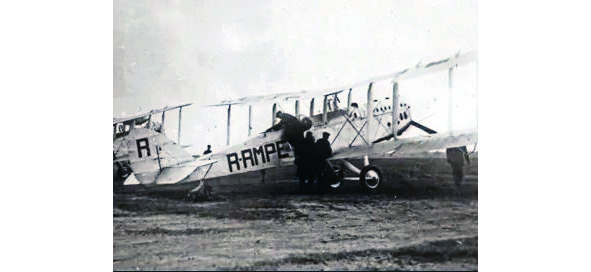
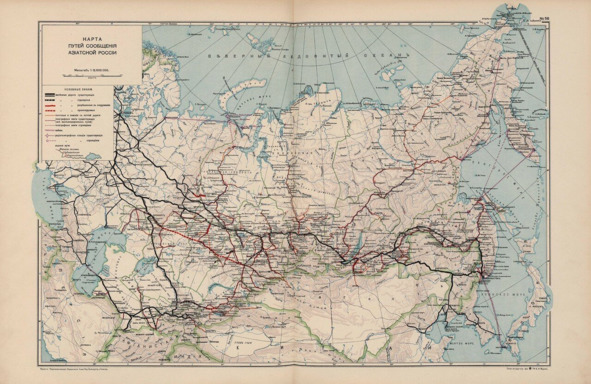
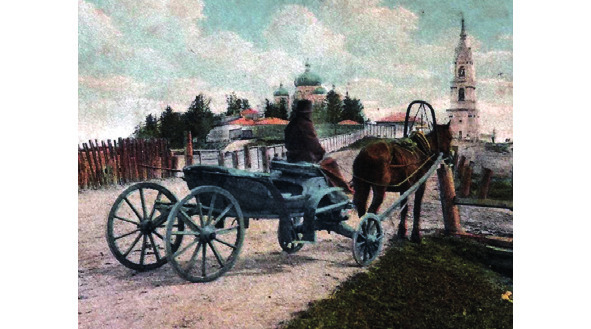
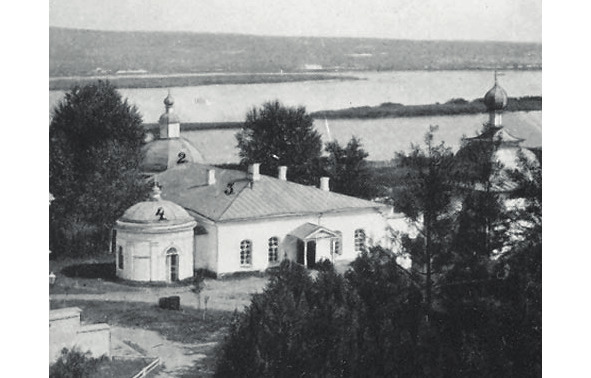
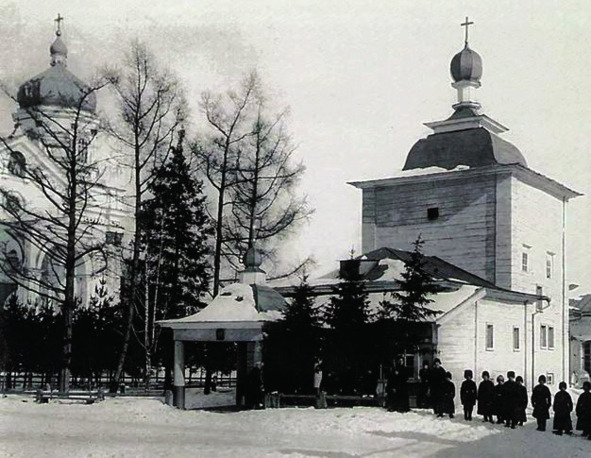
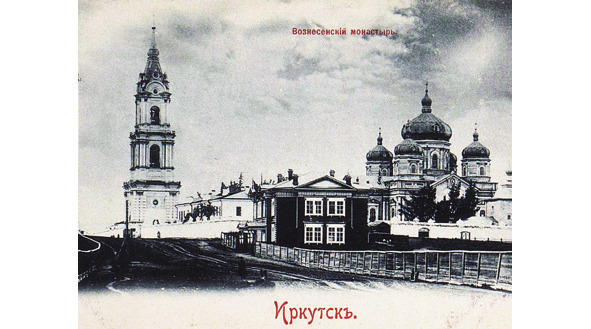
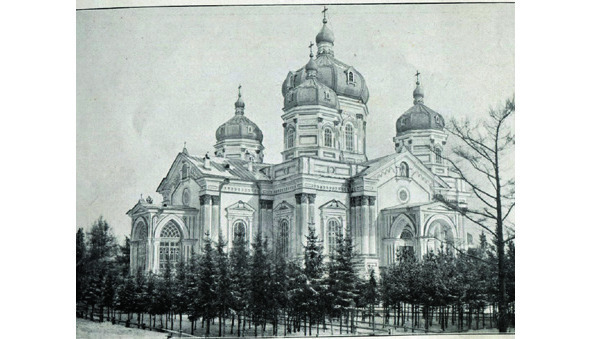
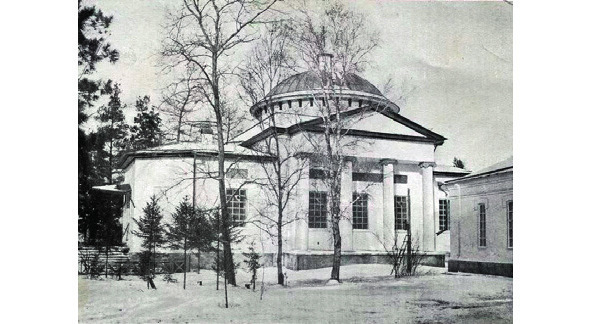
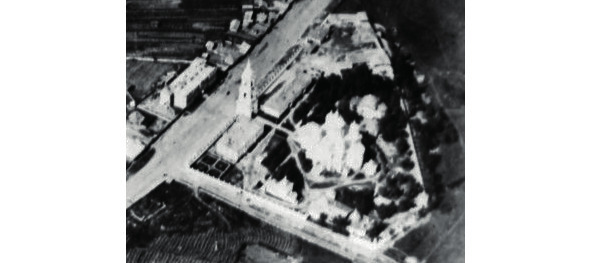
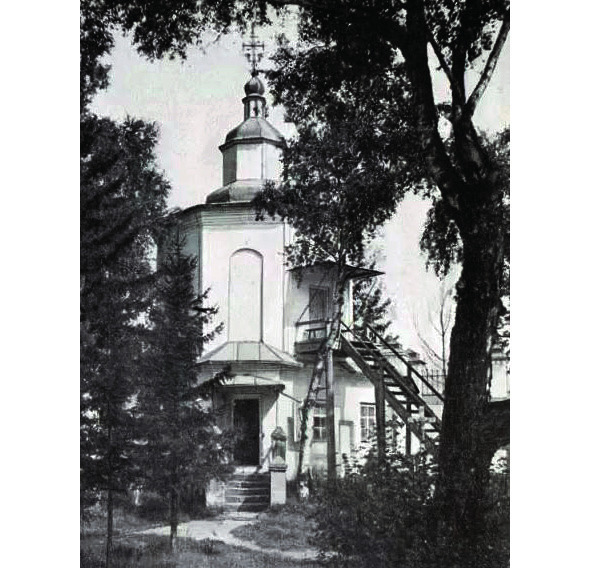
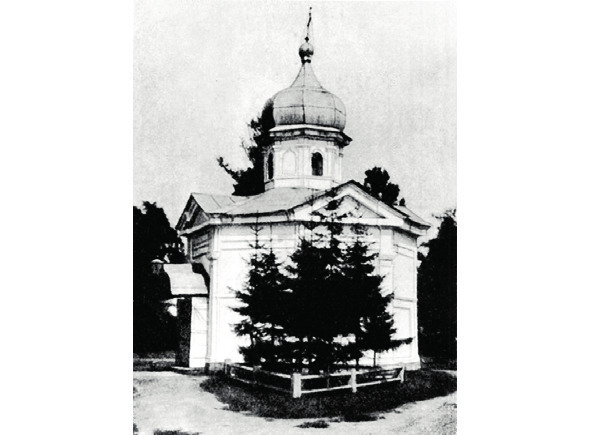
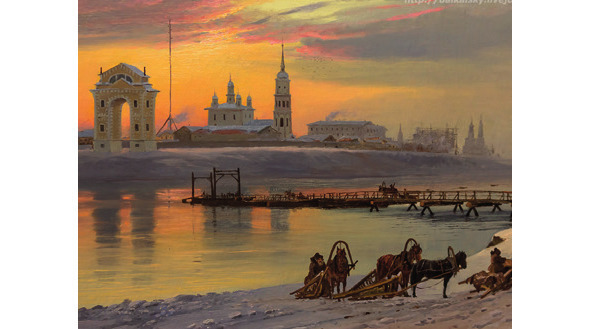
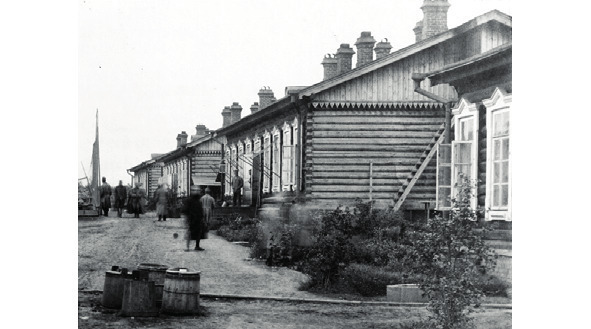
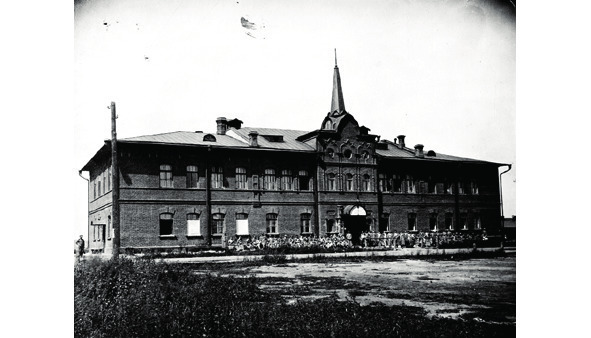
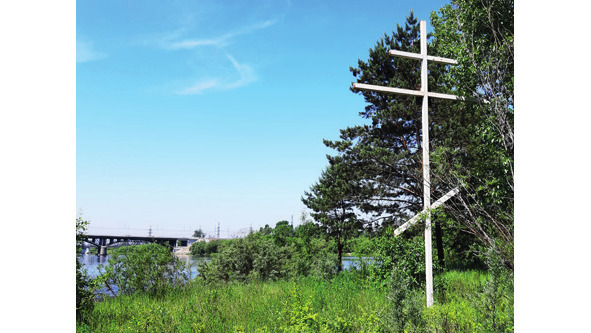
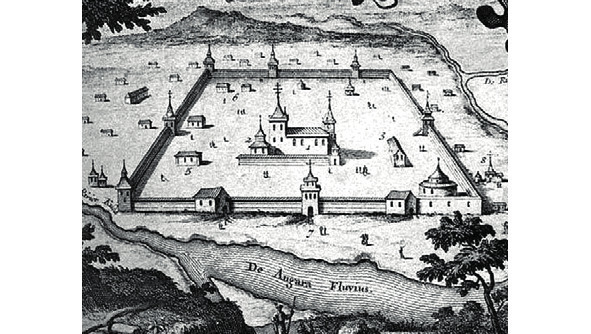
Glazkovo Microdistrict
From the bridge over the Irkut, we enter the Kaya Mountain, which glorified the city to the whole world with the discovery of the Glazkovo necropolis – the largest ancient burial ground on the territory of the modern metropolis. On the whole territory of Eastern, Western Siberia and the Far East taken together, as many burials of the Stone Age were found as at the area of Lokomotiv stadium in Irkutsk. Moreover, this is only 2% of the total number of finds in Glazkovo, many of which are the most valuable artifacts that adorn collections of many museums in Siberia and central Russia.
Artifacts of the Glazkovo necropolis
We will continue moving along Botkin street. Here, at the turn of the road on the right, you can see the building of an old hospital (Botkin Str., 4В), which is the only one preserved from the huge complex of the resettlement center of the Eastern Part of the Siberian Railway, built in 1906 for the needs of landless peasants coming from European Russia to live in Siberia and on the Far East. In this building since 1912 as local doctor worked M.P. Gerasimov in in whose family was born the famous scientist M.M. Gerasimov. Even at the age of 9, little Misha collected strange stones in the vicinity of his house and brought them to the local history museum, where he showed them to the Swiss archaeologist B.E. Petri. In 2007, during the construction of a new building (Dzhambul Str., 30), a 36,000-year-old site was opened, traces of which were found in 1924 by a young archaeologist. A few thousand items as unique pendants made of talc, articles made of rhinoceros and mammoth bones and tools of labor were found.
Archaeologist B.E. Petri (1884—1937)
The career of a professional archaeologist M.M. Gerasimov began in 1928 by conducting excavations right in next to his house at the Cyclodrom park, opened in 1891 for the first cycling races in Irkutsk. Today, this territory bears the name of the Paris Commune, and part of it is occupied by Lokomotiv railroad stadium, built in 1954. This is certainly an iconic place for Irkutsk. Since 1984, the ancient burial grounds have been preserved here under special asphalt caps for the creation in 2023 the first mankind history museum in Russia.
Archaeologist M.M. Gerasimov (1907—1970)
Opposite the stadium, in a five-story building, there is the Siberian Federal Scientific Center for Agrobiotechnologies of the Russian Academy of Sciences, since 1979 it has been subordinate to research institutes, breeding and experimental stations operating throughout Siberia (Botkina Str., 4). Its neighbor is the Irkutsk Interregional Veterinary Laboratory, which has been operating here since 2003 and serves about 30% of the territory of the Russian Federation (Republic of Buryatia, Republic of Sakha, Zabaykalsky Kray, Irkutskaya Oblast). Today, this creates a scientific basis for the agro-industry in the vast Siberian territory.
Garden «Locomotive» and the monument to I.V. Stalin, 1950s
At the intersection with 2nd Zheleznodorozhnaya Street, on the right side, it is hard not to notice the buildings of the Road Clinical Hospital of the Eastern Railway (Botkin Str., 10), built in 1965 to serve railway workers and their families. Directly behind them, in a relic pine grove, is the territory of the «Angara» health resort. It was built at the expense of the merchant of the 1st guild I.L. Medvednikov as a hospital for chronic patients in 1901. The old building of the medical institution can still be seen if you go down the street to Irkut River (2nd Zheleznodorozhnaya Str., 4). The construction project was created by the famous Irkutsk architect A.I. Kuznetsov.
Medvednikovs hospital for chronic patients, 1911
Today, here is the hospital which houses the Irkutsk State Medical Academy of Postgraduate Education, which was created on the basis of a physiotherapy institute that opened here in 1932. During the WWII, there was a neurosurgical officer’s evacuation hospital, and after the victory in 1955, a sanatorium with mineral waters was opened. It operates in our time, scientific research is being carried out, new methods of treatment are being introduced.
Health resort «Angara»
We reach the intersection with Kasyanova street. In the past, this area was mostly inhabited by families of railway workers, due to the proximity of the station. At the intersection with Ostrovsky Street (Kasyanova Str., 35) there is a lonely wooden house in which the future famous film director L.I. Gaidai lived since 1937. In the summer of 1961 here he wrote the script for the film «Dog Barbos and Unusual Cross» while visiting his parents. By the 350th anniversary of Irkutsk, it was planned to create the director’s memorial museum with a cinema alley. However, the plans were not destined to come true due to litigation between the heirs of L.I. Gaidai.
Monument to L.I. Gaidai in Irkutsk
Let’s go down the street the same way that young Leonid went to school every day. At the intersection with 2nd Zheleznodorozhnaya Street, we are greeted by a completely ordinary wooden house (Kasyanova Str., 17), where since 1900 lived the famous creator of the publishing house «Irisy» M.E. Stozh. He not only published pocket guides about Siberia and postcards with views of Irkutsk, but also published such outrageous Russian poets as A.S. Sorokin and D.D. Burliuk. Next to it is the Center for the Culture of the Indigenous Peoples of Baikal Region.
We continue to move along Kasyanova Street and turn left at the intersection with Profsoyuznaya. At the crossroads, on the so-called Mogilev’s site, you can see the memorial complex, installed in 1967 on the site of a mass grave of 19 participants in the uprising against A.V. Kolchak in the Glazkovo suburb in December 1919.
Memorial at the Mogilev site
A little further away you can see an old brick building built in 1916 according to the project of V.I. Kolyanovsky for the primary railway school, which was later transformed into the school No. 10 and then No. 42 (Profsoyuznaya Str., 3). Here was the headquarters of the worker-peasant squads during the battles on December 1917. Until 1941, a famous film director L.I. Gaidai studied here, who graduated from school three days before the start of the war. Among the graduates of the school there are other famous personalities: the writer I.I. Molchanov-Sibirsky, author of the method of restoring the human appearance of a person based on the skeletal remains M.M. Gerasimov, the first director of the Irkutsk Institute of the Earth’s Crust N.A. Florensov and many others.
Railway Lyceum No. 36
In 2002, according to the plan of the architect S.A. Chumakov, a new school building appeared nearby, which two years later was transformed into the Russian Railways Lyceum No. 36. Until the middle of the 20th century, a very picturesque wooden church built in 1916 and the almshouse of the educational brotherhood of Saint Innocent stood on this site.
Church of St. Innocent, first half of the 20th century
On the left, at the intersection with Mayakovskogo Street, you can see a stele dedicated to the Sverdlovsk district of Irkutsk. It stands opposite the magnificent wooden tenement house of the Verkholensk merchant A.N. Abramov (Mayakovskogo Str., 5). From here we will go down to Dzhambul Street, which is named after the famous Kazakh poet and winner of the Stalin Prize. But before that, let’s linger on the top of the Kaya mountain and admire one of the best panoramas of Irkutsk city.
The Glazkovsky Bridge, the oldest in Irkutsk, goes to the right bank of Angara River. And, although it had a predecessor like pontoon Nikolaevsky bridge, the remains of which are still visible near the shore downstream (it existed since 1891), nevertheless, a permanent crossing appeared in Irkutsk only in 1936. By the time it was put into operation, this was the most longspan reinforced concrete bridge in the USSR. The architect of the bridge I.A. Frantsuz was the author of the project of the mausoleum of V.I. Lenin on Red Square in Moscow. And on the last parapet pedestal on the left towards the city, you can still see a sign stating that this bridge is a real «monument to V.I. Lenin.»
Glazkovsky bridge, 1936
In the meantime, we will turn right and continue our movement along Chelnokov Street, named after the twice Hero of the Soviet Union, General N.V. Chelnokov, who made more than 270 sorties, bringing death to the enemy in the air and on the ground from the Baltic to Black Sea. How symbolic that he was born in Irkutsk on a Great Victoru Day on May 9, 1906. A monument to him was set here at the entrance group to the Sverdlovsk region, in a small square at the foot of the Kaya Mountain. However, this was done unforgivably late: only on October 2, 2016, on the 110th anniversary of the birth of the aviation general.



